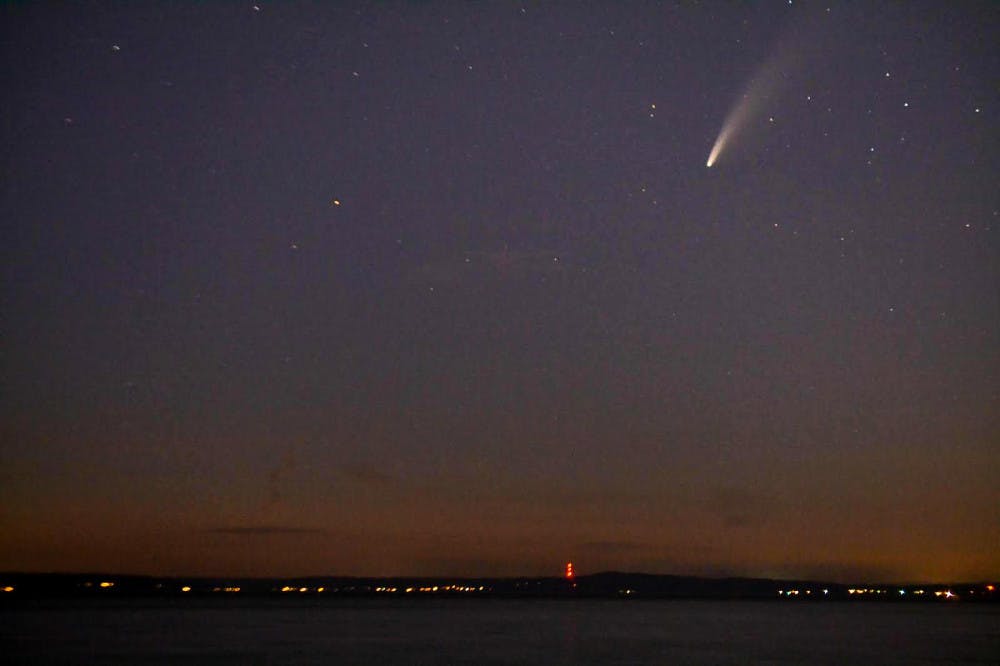The recent comet is just one of many observable space phenomena over the next few months.
By Jana Obune and Corinna Cook

Astronomers and hobbyists alike have spent the last few weeks looking up at the night sky. To the northwest, near the Big Dipper, the comet NEOWISE could be seen passing close to Earth. It looked like a star with a bright trail of light.
Palome Cooke, a student at Western, keeps astronomy as a hobby and had the opportunity to observe NEOWISE while it was still bright.
“It was very faint, you could barely see it with your bare eyes but you could tell there was one bright star and a trail of bright fragments behind it,” said Cooke.
NEOWISE is a relatively new discovery. It was found earlier this year on March 27, according to NASA. Although the comet has been visible since mid-July, it reached its peak on July 23 and is beginning to fade. It won’t be seen again for another 6,800 years.
“Visually it's been really just beautiful,” said Greg Scheiderer, a writer for Seattle Astronomy and member of the Seattle Astronomical Society. “I've gone up several evenings just to catch a look at it as it now gets dimmer and dimmer and further from us.”
It’s a rare occurrence for someone to experience the same comet twice in a lifetime. According to Brad Snowder, Western’s Spanel Planetarium manager, Mark Twain was one of the lucky few who got to experience Halley’s Comet twice. It appeared the year he was born, 1836, and the year he died, 1910. The comet only becomes visible to the naked eye about every 76 years.
“I’m not sure what the magnitude is now, but NEOWISE is pretty much gone,” Snowder stated.
Snowder went on to say that once a comet, in this case NEOWISE, hits the outer solar system, it fades very quickly.
NEOWISE is named after the telescope that originally spotted it, short for Near-Earth Objects Wide-field Infrared Survey Explorer, according to the mission’s webpage.
“They’re always doing gymnastics to get cool acronyms like that,” said Scheiderer.
Scheiderer said comets are sometimes known as dirty snowballs, since they are essentially gravel held together by ice.
NASA describes comets as masses of frozen gases, rocks and dust that orbit the sun. As they get closer to the sun they heat up. The gases and dust escape, forming a glowing tail that extends away from the sun.
Snowder said that comets come from the outer solar system where scientists can’t detect them until the comet's path leads it closer to Earth.
“One day we notice one and then it gets bright for a few weeks or a couple of months. Then they head back out [to the outer solar system]. Once we've seen them, then we can map out their orbit and we know when to expect them after that,” Snowder said.
Dino Bektešević, a University of Washington graduate student, is working on a long-term project that would view objects in space further away than we are currently able to observe. Scientists around the world are developing a telescope and software that will observe and take photos of different parts of the sky every three days. These photos can then be overlaid, and the dimmest objects will become visible, much like long exposure on a camera. This will help scientists see comets sooner.
Aside from NEOWISE, there are other celestial events to look forward to in the night sky. For example, Perseverance, the new Mars rover, recently launched on July 30. It is expected to land in the Jezero Crater on Feb. 18, 2021 and will seek out any evidence of ancient life on the now barren planet.
There is also the Perseid meteor shower that occurs every year in mid-August. The meteors are best seen a few hours before dawn, according to NASA. Meteors come from dust left behind by asteroids and comets, and each year Earth passes through this debris.
The Perseids may appear to be related to the constellation Perseus, which is how they got their name, but that’s not where the meteor showers originate from. The name Perseids is used as a guideline to help observers know where to look.
Scheiderer said he looks forward to the Perseids every year. “If you can get to a dark sky place, that can be pretty spectacular,” he said.
The positions of the planets in our solar system can also make for interesting sky viewing. For example, Jupiter and Saturn are currently visible for most of the night. Mars will reach opposition later in the year, but is currently visible in the east before sunrise.
“If you live in a busy area or crowded area, try and go somewhere where there's almost total darkness and bring binoculars or a telescope,” Cooke said. “Try to avoid using your phone because the blue light will make your eyes not adjust to the darkness.”
Snowder stated that if you want to observe anything in the sky, whether it’s a comet or an asteroid, you need to get a little bit out of town. North of Bellingham, east toward the mountains, and the northwest toward the islands are good locations. These areas tend to be darker with less light pollution from cities, making it easier to see more than just the brightest stars and planets.
“If you go out to Acme area or out anywhere east of town towards the Everson Goshen Road, you get good views of the south,” Snowder said.
If you are unable to get out of town, try to find somewhere without direct city lights. According to Scheiderer, a lot of parks are good. You can still see the brightest stars and planets, as well as the moon, from your local Albertson’s parking lot.
“The sky is everywhere,” said Scheiderer. “Look up and see, there's bound to be something interesting.”





